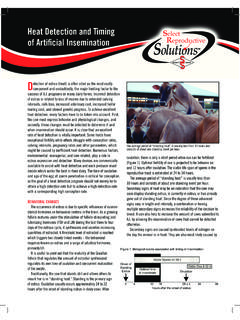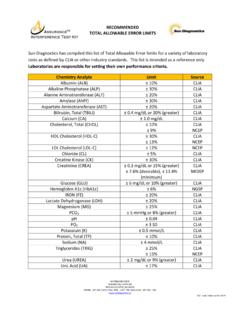Transcription of TM - Keppra XR® (levetiracetam)
1 Mouth ulceration, rash and respiratory failure. Each of theseadverse reactions led to discontinuation in a Keppra XR-treated patient and no placebo-treated Of Gender, Age And RaceThere are insufficient data for Keppra XR to support astatement regarding the distribution of adverse experiencereports by gender, age and 3 lists the adverse reactions seen in the well-controlled studies of immediate-release Keppra tablets inadult patients experiencing partial onset seizures. Althoughthe pattern of adverse reactions in the Keppra XR studyseems somewhat different from that seen in partial onsetseizure well-controlled studies for immediate-releaseKEPPRA tablets, this is possibly due to the much smallernumber of patients in this study compared to theimmediate-release tablet studies.
2 The adverse reactions forKEPPRA XR are expected to be similar to those seen withimmediate-release Keppra Keppra TabletsIn well-controlled clinical studies of immediate-releaseKEPPRA tablets as adjunctive therapy to other AEDs in adultswith partial onset seizures, the most frequently reportedadverse reactions, not seen at an equivalent frequencyamong placebo-treated patients, were somnolence,asthenia, infection and 3 lists treatment-emergent adverse reactions thatoccurred in at least 1% of adult epilepsy patients treatedwith immediate-release Keppra tablets participating inplacebo-controlled studies and were numerically morecommon than in patients treated with placebo.
3 In thesestudies, either immediate-release Keppra tablets orplacebo was added to concurrent AED therapy. Adversereactions were usually mild to moderate in 3:Incidence (%) Of Treatment-Emergent Adverse ReactionsIn Placebo-Controlled,Add-On Studies In Adults ExperiencingPartial Onset Seizures By Body System (Adverse ReactionsOccurred In At Least 1% Of Immediate-Release Keppra -TreatedPatients And Occurred More Frequently Than Placebo-TreatedPatients)In addition, the following adverse reactions were seen inother well-controlled studies of immediate-release Keppra tablets.
4 Balance disorder, disturbance in attention, eczema,hyperkinesia, memory impairment, myalgia, personalitydisorders, pruritus, and vision ExperienceInaddition to the adverse reactions listed above forimmediate-release Keppra tablets [see Adverse Reactions( )], the following adverse events have been identifiedduring postapproval use of immediate-release Keppra tablets. Because these events are reported voluntarily fromapopulation of uncertain size, it is not always possible toreliably estimate their frequency or establish a casualrelationship to drug exposure.
5 The listing is alphabetized:abnormal liver function test, hepatic failure, hepatitis,leukopenia, neutropenia, pancreatitis, pancytopenia (withbone marrow suppression identified in some of thesecases), suicidal behavior (including completed suicide),thrombocytopenia and weight loss. Alopecia has beenreported with immediate-release Keppra use; recovery wasobserved in majority of cases where immediate-releaseKEPPRA was InformationIn vitrodata on metabolic interactions indicate that KEPPRAXR is unlikely to produce,or be subject to, pharmacokineticinteractions.
6 Levetiracetam and its major metabolite, atconcentrations well above Cmaxlevels achieved within thetherapeutic dose range, are neither inhibitors of nor highaffinity substrates for human liver cytochrome P450isoforms, epoxide hydrolase or UDP-glucuronidationenzymes. In addition, levetiracetam does not affect the invitroglucuronidation of valproic circulates largely unbound (<10% bound) toplasma proteins; clinically significant interactions with otherdrugs through competition for protein binding sites aretherefore pharmacokinetic interactions were assessed inclinical pharmacokinetic studies (phenytoin, valproate, oralcontraceptive, digoxin, warfarin, probenecid) and throughpharmacokinetic screening with immediate-release Keppra tablets in the placebo-controlled clinical studies in epilepsypatients.
7 The following are the results of these studies. Thepotential for drug interactions for Keppra XR is expected tobe essentially the same as that with immediate-releaseKEPPRA Keppra tablets (3000 mg daily) had noeffect on the pharmacokinetic disposition of phenytoin inpatients with refractory epilepsy. Pharmacokinetics oflevetiracetam were also not affected by Immediate-release Keppra tablets (1500 mg twice daily)did not alter the pharmacokinetics of valproate in healthyvolunteers. Valproate 500 mg twice daily did not modify therate or extent of levetiracetam absorption or its plasmaclearance or urinary excretion.
8 There also was no effect onexposure to and the excretion of the primary metabolite, Antiepileptic DrugsPotential drug interactions between immediate-releaseKEPPRA tablets and other AEDs (carbamazepine,gabapentin,lamotrigine,ph enobarbital,phenytoin,primidone and valproate) were also assessed by evaluatingthe serum concentrations of levetiracetam and these AEDsduring placebo-controlled clinical studies. These dataindicate that levetiracetam does not influence the plasmaconcentration of other AEDs and that these AEDs do notinfluence the pharmacokinetics of ContraceptivesImmediate-release Keppra tablets (500 mg twice daily) didnot influence the pharmacokinetics of an oral contraceptivecontaining mg ethinyl estradiol and mglevonorgestrel, or of the luteinizing hormone andprogesterone levels, indicating that impairment ofcontraceptive efficacy is unlikely.
9 Coadministration of thisoral contraceptive did not influence the pharmacokineticsof Keppra tablets (1000 mg twice daily)did not influence the pharmacokinetics andpharmacodynamics (ECG) of digoxin given as a mgdose every day. Coadministration of digoxin did notinfluence the pharmacokinetics of Keppra tablets (1000 mg twice daily)did not influence the pharmacokinetics of R and S time was not affected by of warfarin did not affect thepharmacokinetics of , a renal tubular secretion blocking agent,administered at a dose of 500 mg four times a day, did notchange the pharmacokinetics of levetiracetam 1000 mgtwice daily.
10 Cssmax of the metabolite, ucb L057, wasapproximately doubled in the presence of probenecid whilethe fraction of drug excreted unchanged in the urineremained the same. Renal clearance of ucb L057 in thepresence of probenecid decreased 60%, probably relatedto competitive inhibition of tubular secretion of ucb effect of immediate-release Keppra tablets onprobenecid was not IN SPECIFIC Category CThere are no adequate and well-controlled studies inpregnant women. In animal studies, levetiracetam producedevidence of developmental toxicity, including teratogeniceffects, at doses similar to or greater than humantherapeutic doses.




